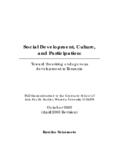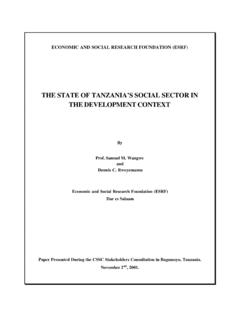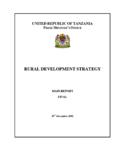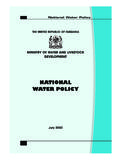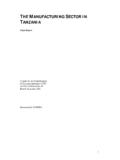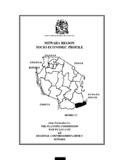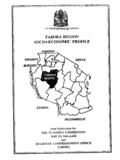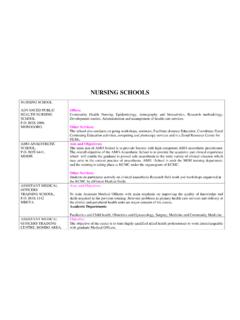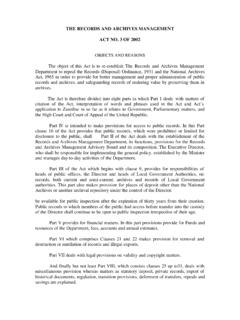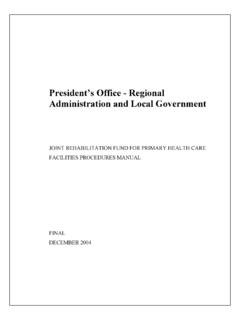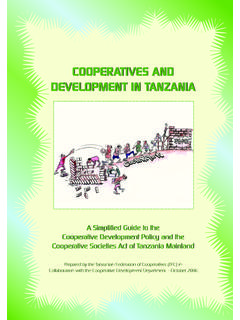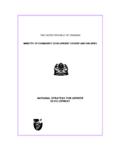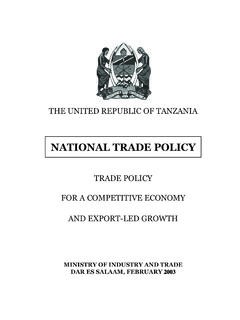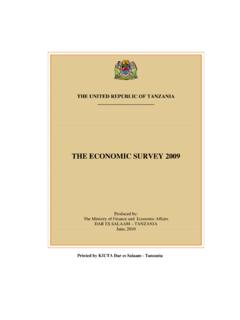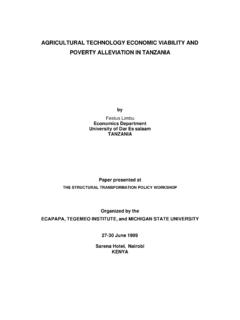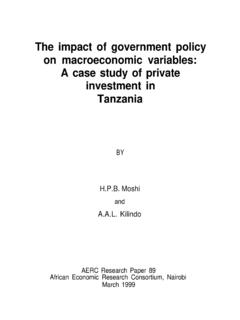Transcription of MWANZA REGION SOCIO-ECONOMIC PROFILE - Tanzania …
1 KENYAUGANDARWANDABURUNDIZAMBIAMSUMBIJITH E UNITED REPUBLIC OF TANZANIAMWANZA REGIONSOCIO-ECONOMIC PROFILEJ oint Publication by:THE PLANNING COMMISSIONDAR ES SALAAMandREGIONAL COMMISSIONER'S OFFICEMWANZAMWANZA iTABLE OF CONTENTS Page SECTION LAND PEOPLE AND REGIONAL GEOGRAPHICAL LAND AREA AND ADMINISTRATIVE ETHNIC GROUPS:..4 POPULATION SIZE GROWTH AND DENSITY:..4 MIGRATION:..18 EMPLOYMENT:..21 CLIMATE AND SOILS:..22 AGRO-ECONOMIC ZONES AND TOPOGRAPHY:..23 SECTION REGIONAL ECONOMY:..28 INTRODUCTION:..28 GDP AND PER CAPITA GDP:..28 PRODUCTIVE SECTORS:..36 AGRICULTURE:..36 FOOD AND CASH CROP PRODUCTION:..39 AGRICULTURAL INPUTS:..49 IRRIGATION:..50 LIVESTOCK:..51 FORESTRY:..70 FISHERIES:..77 BEEKEEPING:..83 WILDLIFE:..87 INDUSTRIAL DEVELOPMENT:..89 MINING:..98 SECTION ECONOMIC ROADS.
2 102 MARINE RAILWAY AIR COMMUNICATION SECTION SOCIAL EDUCATION PRIMARY SCHOOL PRIMARY SCHOOL SECONDARY SCHOOL ADULT VOCATIONAL HEALTH HEALTH MANPOWER LIFE EXPECTANCY AT INFANT AND UNDER FIVE MORTALITY:..161 MATERNAL IMMUNIZATION OF A I D OTHER HEALTH DEVELOPMENT WATER RURAL WATER URBAN WATER OVERALL WATER SUPPLY ADMINISTRATION OF WATER SUPPLY OTHER RELATED S E C T I O N OTHER DEVELOPMENT WOMEN NON-GOVERNMENTAL ORGANIZATIONS (NGOS)..191 REGIONAL DEVELOPMENT PROGRAMS SUPPORTED BY ENVIRONMENTAL SECTION POTENTIAL INVESTMENT AREAS:..201 AGRICULTURE:..201 LIVESTOCK:..202 TRANSPORT:..203 HEALTH:..205 ENVIRONMENTAL PROTECTION:..206 TOURISM:..206 MINING:..207 EDUCATION.
3 207 FORESTRY:..208 FISHERIES:..209 BEEKEEPING:..211 WATER WOMEN INDUSTRIAL ANNEX MWANZA REGION IN A LOCATION:..213 LAND FRONTIERS:..213 A N N E X MAGU A N N E X ivKWIMBA A N N E X MISUNGWI A N N E X GEITA A N N E X SENGEREMA A N N E X UKEREWE A N N E X MWANZA ANNEX GENERAL INFORMATION ABOUT Land Arable Land:..239 Mountain summits (metres above sea level)..239 SOCIAL HEALTH Education: Enrolment rates 1995 compared with other East Africa countries241 NATIONAL vFOREWORD 1. As we approach the 21st Century the problems facing rural areas in developing countries like Tanzania are numerous and formidable. Social and Economic services are deteriorating and proving to be unsustainable; school enrollment rates are declining; food situation is precarious; infant and maternal mortality rates continue to be high; unemployment is on the rise triggering off mass migration of youth from the rural areas into already overcrowded urban centres; in MWANZA REGION , for example, land pressure is escalating and deforestation is going on at an alarming rate.
4 2. This situation has arisen because of many factors including ill - prepared rural development programmes and weak monitoring and supervision of the implementation of development programmes and sectoral strategies. The observed shortcomings in the policy formulation, project identification, design, and implementation in the developing countries is in turn attributed to lack of reliable and adequate data and information on the rural development process. 3. The publication of Regional SOCIO-ECONOMIC Profiles series by the Planning Commission in collaboration with Regional Commissioner's offices should be viewed as a fruitful attempt towards finding solutions to the existing problem of data and information gap. 4. The Regional PROFILE series cover a wide range of data and information on geography, population, social economic parameters, social services, economic infrastructure and viproductive sectors.
5 The publications so far have proved to be of high demand and a vital source of information to many policy makers, planners, researchers, donors and functional managers. The Planning Commission has found it a worthwhile effort to extend the exercise to cover even more regions. Readers are invited to make suggestions and constructive criticisms which can assist in improving the quality and effectiveness of future Profiles. 5. I would like to take this opportunity to acknowledge with thanks once again the financial support of the Royal Norwegian Embassy which facilitated the preparation of the MWANZA REGION SOCIO-ECONOMIC PROFILE . I would also like to thank both the Planning Commission and MWANZA Regional Planning Staff who put a lot of effort into ensuring the successful completion of this task.
6 Nassoro W. Malocho (MP) MINISTER OF STATE PLANNING AND PARASTATAL SECTOR REFORM Octoberr 1997 1 SECTION I LAND PEOPLE AND CLIMATE REGIONAL OVERVIEW GEOGRAPHICAL LOCATION MWANZA REGION lies in the northern part of Tanzania , located between latitude 10 30' and 30 south of the Equator . Longitudinally the REGION is located between 310 45' and 340 10' east of Green wich. Regions boardering MWANZA REGION are Kagera to the west, Shinyanga to the south and south east. The north east boarders Mara REGION . The northern part of MWANZA is surrounded by the water of Lake Victoria which in turn separates the REGION from neighbouring countries of Uganda and Kenya (see Map of Tanzania ). MWANZA is a relatively small REGION occupying percent of the total land area of Tanzania mainland.
7 LAND AREA AND ADMINISTRATIVE UNITS MWANZA REGION occupies a total of 35,187 sq km., out of this area 20,095 sq km. is dry land and 15,092 sq km. is covered by Lake Victoria. Thus 43% of the REGION s surface area is water. District wise the REGION is divided as shown in See also figure 1 and figure 2. 2 Fig. 1: Distribution of surface area, MWANZA REGION Land57%Water43% Table : LAND AREA AND ADMINISTRATIVE UNITS District Dry Land (sq km) Area Water Area (sq km) Total Area (sq km) % of Total regional Area Magu 3,070 1,725 4,795 Ukerewe 640 5,760 6,400 Geita 6,775 1,050 7,825 Sengerema 3,335 5,482 8,817 Kwimba 3,903 - 3,903 Misungwi 1,947 175 2,122 MWANZA 425 900 1,325 Total 20,095 15,092 35,187 100 3 Fig. 2 Land Distribution by District in MWANZA REGION Magu MWANZA REGION , which was formerly divided into six administrative districts has been reorganized into seven districts as from July 1996.
8 Missungwi is the newly established district of the REGION excised from Kwimba district. The districts are divided into 33 Divisions, these in turn are further subdivided into 168 Wards. The village is the basic administrative unit. There are 682 villages in MWANZA REGION (Table I-2). 4 Table I-2: LAND AREA AND ADMINISTRATIVE UNITS, MWANZA REGION , 1997 District Land Area Km2 Division Wards Villages Magu 3,070 6 27 116 Kwimba 3,903 5 25 110 Misungwi 1,947 4 20 78 Geita 6,775 7 27 163 Sengerema 3,335 5 25 124 Ukerewe 640 4 24 74 MWANZA 425 2 20 17 Total 20,095 33 168 682 Source: Mkakati wa Maendeleo Mkoani MWANZA 1996 - 2001 (1997). ETHNIC GROUPS: The main ethnic groups in MWANZA REGION are the Sukuma, Zinza, Haya, Sumbwa, Nyamwezi, Luo, Kurya, Jita and Kerewe. The Sukuma dominate by constituting over 90 percent of the population.
9 The rest of the groups constitute in various small proportions. They are mainly in the MWANZA Municipal area. The Sumbwa and Zinza are mostly found in Geita and Sengerema districts respectively. National policy gives very little importance to ethnic grouping and information related to this issue is difficult to come by . POPULATION SIZE GROWTH AND DENSITY: 5 MWANZA REGION has the largest population of any REGION in Tanzania . It has a population of 1,878,271 according to the 1988 census (Table I-3). This was about percent of the total population of Tanzania mainland which was 23,174,443. Table I-4 highlights 1967, 1978 and 1988 MWANZA REGION s population size by district. Observation of census data shows how the population of MWANZA REGION is unevenly distributed over the regional land area.
10 Geita district had the highest population number followed by Kwimba and last of all by Ukerewe. Between the 1967 and 1988 censuses the REGION s population increased by 76 per cent that is from 1,064,883 to 1,878,271. Annual growth rates by district provide projections of district populations for the years 1995, 1998 and 2000 (Table I-4). Table I-3: POPULATION PROJECTIONS BASED ON 1978/88 AVERAGE GROWTH RATES, MWANZA REGION District 1967 Census 1988 Census Population Projections 1995 1998 2000 Magu 243,822 310,918 358,200 415,016 439,434 Kwimba 305,516 428,135 292,343 303,532 320,142 Misungwi - - 237,397 250,284 263,983 Geita 371,407 439,191 585,545 662,728 719,565 Sengerema - 304,121 361,238 305,608 412,907 Ukerewe 109,277 172,893 204,179 215,455 225,127 MWANZA 34,861 223,013 268,734 29,095 307,026 Total 1,064,883 1,878,271 2,307,636 2,523,718 2,688,184 Source: 1967 and 1988 Population Census Reports.
